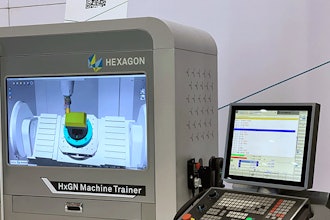3D Printing New Knees
A team at Duke University is 3D printing knee implants with a hydrogel that matches the strength and elasticity of human cartilage.
According to the researchers, this could mean creating custom replacement parts using info taken from your CT scan. Specifically, they printed menisci, the little piece between your shin and thigh bone that stops your bones from rubbing together.
Until now, researchers have struggled to create recipes for synthetic hydrogels that are equal in strength to human cartilage and also 3D-printable. Duke's recipe is one part stiff hydrogel, one part soft and stretchy hydrogel, and then they add in the special ingredient, a nanoparticle clay. This allows the hydrogel to flow like water out of the printer head, and then immediately harden into its printed shape. They call it a double network hydrogel.
The entire process, from scan to finished meniscus, only took a day and they did it on a cheap, $300, 3D printer.
Making Batteries with Broken Glass
Researchers at the University of California, Riverside’s Bourns College of Engineering are smashing old glass bottles to create nanosilicon anodes for lithium-ion batteries. According to the researchers, the batteries will not only extend the range of electric vehicles and plug-in hybrids, but also give our personal electronics more power on fewer charges.
The team used a three-step process to create the anodes. First, they crushed the glass bottles into a fine white power, then a magnesiothermic reduction was used to transform the silicon dioxide into nanostructured silicon. Finally, they coated the silicon nanoparticles with carbon to improve stability and energy storage.
According to the team, one glass bottle provides enough nanosilicon for hundreds of coin cell batteries, which unfortunately still leaves billions ofold bottles headed to the landfill. Who knows, maybe we can find a way to use it in battery holders, two for the money.
Ford Using Tequila, Bamboo Byproducts
Last year, Ford partnered with Jose Cuervo to make car parts from Agave. The plan was to make a sustainable bioplastic material from the agave fiber byproduct after the plant’s heart is harvested to make tequila. It's quite possibly the only way an alcohol producer could partner with a car manufacture, and yet it's only one of the company's many projects to find a use for sustainable and recycled materials.
This week, researchers at Ford’s Nanjing Research & Engineering Center in China said that they have spent the last few years working with bamboo, to try and find a way to use it for vehicle interiors and make stronger parts by combining it with plastic. The team actually found that bamboo performs much better than synthetic and natural fibers, particularly when it comes to tensile and impact strength. It can also withstand more than 212 degrees Fahrenheit, which can stand up to pretty much anything on a car unless the entire thing catches fire.
The bamboo and tequila chaff are just a couple of the company's efforts to make its vehicles more sustainable that might already be in your vehicle. The company uses:
- Tropical plants to make Ford Escape doors.
- REPREVE fabric, which made from recycled plastic bottles, in the F-150.
- Cotton from denim and T-shirts as interior padding and sound insulation.
- Old tires for seals and gaskets in most vehicles.
- Rice hulls used in F-150 electrical harnesses.
- Cellulose tree fibers in the Lincoln MKX armrests, where it is used to replace glass-filled plastic. It actually weighs 10 percent less, is produced 30 percent faster, and reduces carbon emissions.
Now that is something I want to hear, Dennis Leary telling us the new F-150 is built Ford tough … with bamboo.
This is Engineering By Design with David Mantey.






















